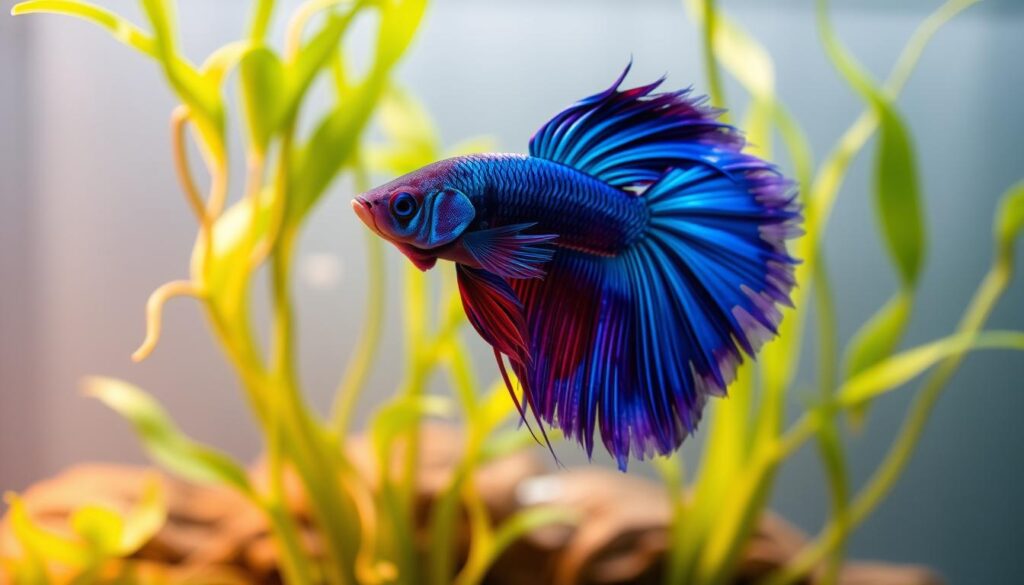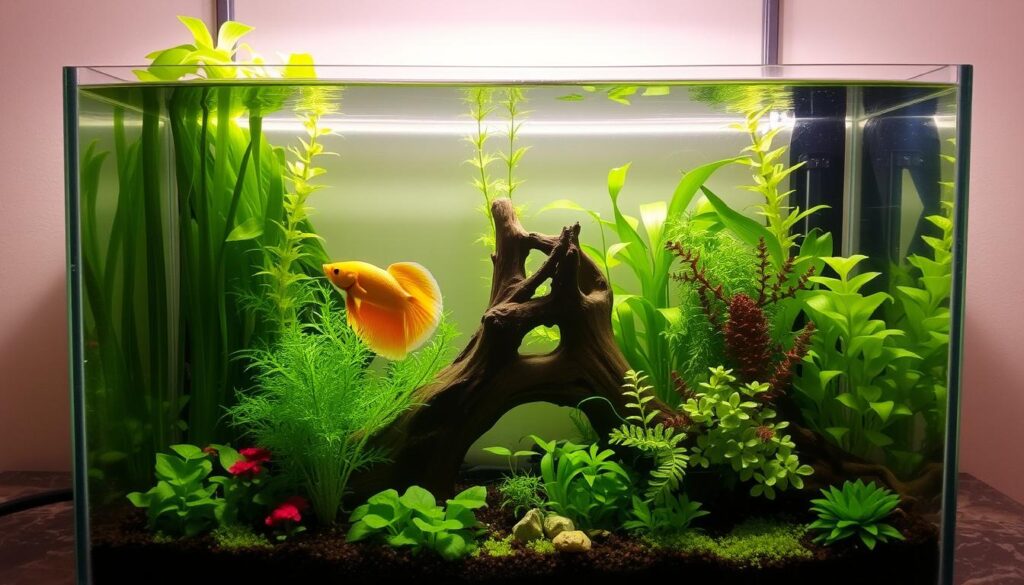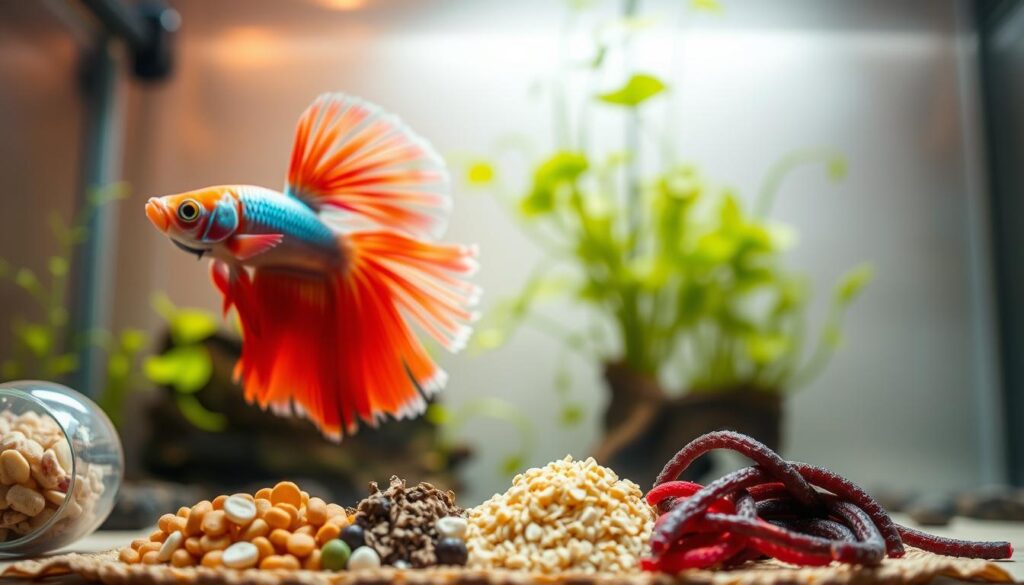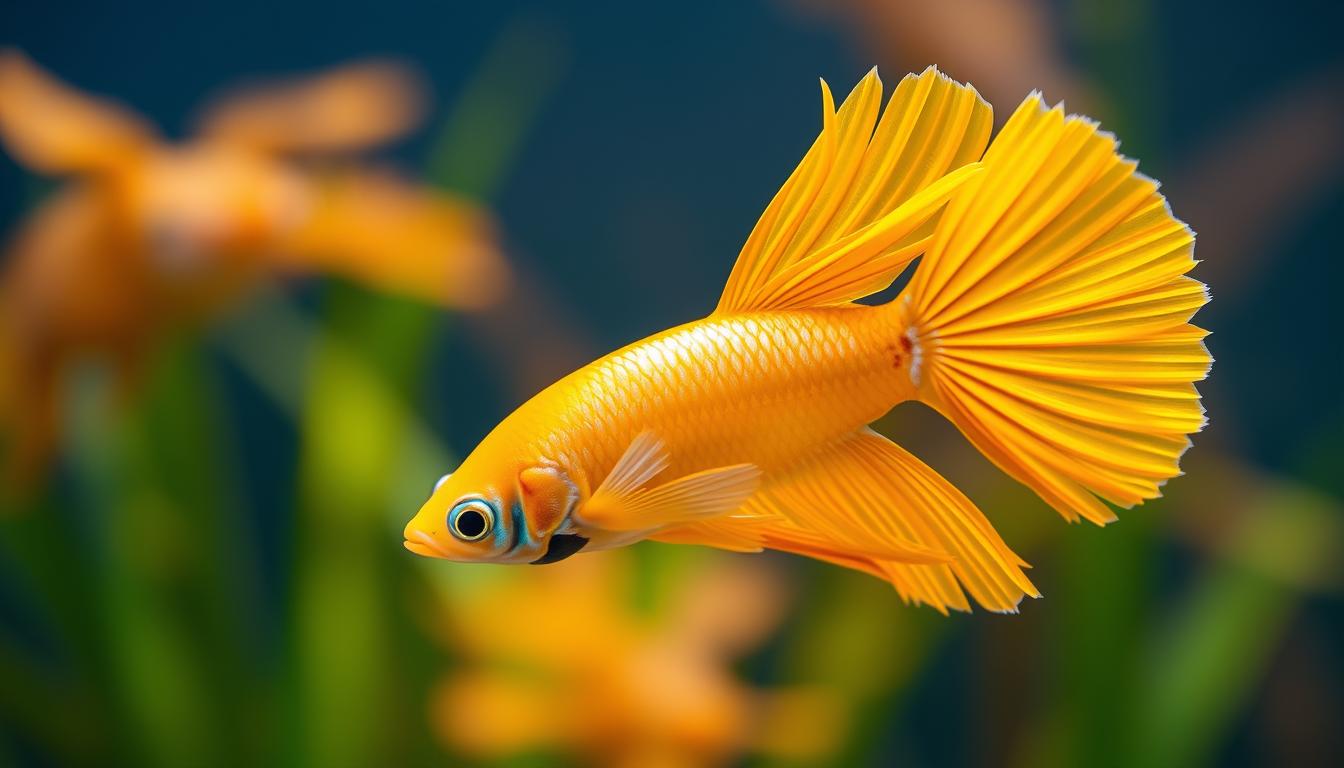Are you ready to add a splash of color and tranquility to your home aquarium? The Mustard Betta Fish is a stunning choice, known for its vibrant hues and serene demeanor. Native to the warm waters of Thailand, these beautiful creatures have captivated aquarium enthusiasts worldwide with their flowing fins and intriguing behaviors.
We love watching our betta fish thrive in their well-cared-for environments, and we’re excited to share the joys of caring for these wonderful pets with you! With proper care, your mustard betta can live a happy, healthy life, bringing joy and serenity to your home.
Key Takeaways
- Mustard Betta Fish are known for their vibrant colors and peaceful nature.
- They are relatively easy to care for, making them perfect for beginners.
- Proper care includes a suitable aquarium environment and a balanced diet.
- Betta Fish can thrive in well-maintained aquariums with the right conditions.
- They are a great choice for those looking to add a unique pet to their home.
The Allure of Mustard Betta Fish
With its unique two-toned coloration, the Mustard Betta has become a highly sought-after addition to many home aquariums. This stunning variant of Betta splendens is not only a treat to behold, but its popularity is also on the rise among aquarists of all levels.
Origin and Development of the Mustard Variety
The Mustard Betta is a result of careful breeding programs aimed at creating new and exciting color variations. Its distinctive coloration is a result of selective breeding, which has enhanced its natural beauty. The development of this variety has been driven by the desire to create a fish that is both visually striking and easy to care for.
Rising Popularity Among Aquarists
The Mustard Betta’s popularity can be attributed to its vibrant colors and relatively low maintenance care. As more people discover the joys of keeping betta fish, the Mustard variety is becoming a favorite. “Betta fish are not just pets, they’re a hobby,” says many an aquarist, and the Mustard Betta is a perfect example of this. With proper betta fish care, these fish can thrive and display their full range of betta fish colors, making them a delightful addition to any aquarium.
Physical Characteristics and Appearance
Let’s dive into the fascinating world of Mustard Betta Fish and explore their stunning physical characteristics! Mustard Betta Fish are renowned for their vibrant colors and elaborate fins, making them a popular choice among aquarists.

Distinctive Coloration Patterns
Mustard Betta Fish display a range of captivating colors. Male Mustard Gas Bettas, for instance, often feature a vibrant body in shades of blue, green, or turquoise, complemented by contrasting yellow, orange, or mustard-colored fins. This striking color combination is a hallmark of the variety.
- Vibrant Body Colors: Blues, greens, and turquoises are common.
- Contrasting Fin Colors: Yellow, orange, and mustard hues add to their appeal.
Fin Types and Variations
The finnage of Mustard Betta Fish is another aspect of their beauty. They come in various fin types, including:
- Crown Tail: Characterized by a distinctive “crown-like” tail.
- Veil Tail: Known for their long, flowing tails.
- Half-Moon: Features a tail that forms a half-moon shape when spread.
Male vs. Female Differences
When it comes to Mustard Betta Fish, males and females exhibit some notable differences. Males are generally more colorful and have longer fins compared to females. Females, while less flashy, still possess a subtle beauty and are often less aggressive.
- Males: More vibrant colors, longer fins.
- Females: Less colorful, shorter fins, often less aggressive.
Mustard Betta Fish vs. Other Betta Varieties
When it comes to Betta fish, the Mustard Betta stands out with its unique two-toned coloration. This distinct feature sets it apart from other popular Betta varieties. Let’s dive into how Mustard Bettas compare to other types, such as Yellow and Gold Bettas, as well as Koi, Galaxy, and Wild-Type Bettas.
Comparison with Yellow and Gold Bettas
Mustard Betta fish are often compared to Yellow and Gold Bettas due to their similar color profiles. However, Mustard Bettas have a distinct two-toned appearance that is not typically seen in Yellow or Gold Bettas. While Yellow and Gold Bettas display a uniform color, Mustard Bettas showcase a beautiful gradient effect.
The unique coloration of Mustard Bettas makes them a favorite among aquarists looking for something different. In terms of care, Mustard Bettas have the same requirements as Yellow and Gold Bettas, making them easy to care for.
| Betta Type | Color Profile | Care Requirements |
|---|---|---|
| Mustard Betta | Two-toned, gradient effect | Standard Betta care |
| Yellow Betta | Uniform yellow | Standard Betta care |
| Gold Betta | Uniform gold | Standard Betta care |
Differences from Koi, Galaxy, and Wild-Type Bettas
Mustard Bettas also differ significantly from Koi, Galaxy, and Wild-Type Bettas. Koi Bettas are known for their large, flowing fins and mixed color patterns, whereas Galaxy Bettas display a metallic sheen. Wild-Type Bettas, on the other hand, have more subdued colors compared to the vibrant Mustard Betta.
While these varieties have their unique features, Mustard Bettas are prized for their peaceful nature and striking appearance. Understanding these differences can help you choose the right Betta for your aquarium.
Setting Up the Ideal Betta Tank
Let’s dive into setting up the perfect Betta tank, a crucial step in keeping your Mustard Betta happy and healthy. Creating the right environment involves several key considerations, from tank size to water conditions and equipment.
Tank Size Requirements
When it comes to housing your Mustard Betta, size matters! A minimum tank size of 10 liters (2.5 gallons) is recommended for a single male Betta. This provides enough space for your Betta to swim and thrive. Larger tanks offer more stability in water parameters, making it easier to care for your fish.
Water Parameters and Conditions
Maintaining the right water conditions is crucial for your Betta’s health. Let’s break down the key factors:
Temperature Range
The ideal temperature for Betta fish is between 76°F and 82°F (24°C to 28°C). Avoid placing your tank near drafts or air conditioning vents to maintain a stable temperature.
pH and Hardness Levels
Betta fish prefer slightly acidic to neutral water, with a pH between 6.5 and 7.5. Water hardness should be moderate, around 5-15 dGH. Regular water changes will help maintain these parameters.
Water Cycling Basics
Water cycling is the process of establishing a colony of beneficial bacteria that convert ammonia into nitrite and then nitrate. This process is crucial before introducing your Betta to the tank. Allow the tank to cycle for at least 2-4 weeks before adding your fish.
Essential Equipment and Filtration
A good filtration system is vital for maintaining clean and healthy water. For a Betta tank, a gentle filter is recommended to avoid strong currents that can stress your fish. Here’s a comparison of some common filtration options:
| Filter Type | Flow Rate | Noise Level | Maintenance |
|---|---|---|---|
| Hang-On-Back Filter | Medium to High | Moderate | Easy |
| Internal Filter | Low to Medium | Low | Moderate |
| Sponge Filter | Low | Very Low | Easy |
As you can see, the choice of filter depends on your specific needs and the size of your tank. Remember, the key to a healthy Betta is a well-maintained environment!

Creating a Natural Habitat Environment
Let’s dive into creating a natural habitat for your Mustard Betta Fish, making their tank a vibrant and welcoming space! To achieve this, we need to consider several key elements: the right plants, a suitable substrate, and appropriate decorations.
Best Plants for Betta Tanks
Choosing the right plants can make all the difference in your Betta’s tank. We recommend plants like Java fern, Anubias, and floating plants such as Amazon frogbit. These plants not only add a touch of natural beauty but also provide hiding spots and shaded areas for your Betta to enjoy. “Plants are essential for creating a natural environment,” says a renowned aquarist, “they help maintain water quality and provide visual stimulation for the fish.”

Substrate Options and Considerations
When it comes to substrate, a soft, sandy bottom is ideal for your Mustard Betta. It’s gentle on their fins and allows for easy cleaning. Avoid gravel or coarse substrates that can cause damage. A well-chosen substrate also enhances the overall aesthetic of the tank, making it more visually appealing.
Decorations and Hiding Places
Decorations are not just for show; they provide essential hiding places and visual barriers for your Betta. You can use a variety of decorations such as plants, rocks, and driftwood to create a natural environment. Remember, the goal is to mimic the natural habitat of your Mustard Betta, so get creative and have fun with it!
By combining the right plants, substrate, and decorations, you’ll create a thriving environment that your Mustard Betta will love. Happy decorating!
Nutrition and Feeding Guidelines
A well-nourished Betta is a happy Betta – let’s dive into the best feeding practices! Feeding your Mustard Betta a balanced diet is essential for its health and well-being. Betta fish have a varied diet and enjoy eating a range of foods.
High-Quality Commercial Foods
High-quality commercial foods should form the staple of your Betta’s diet. Look for Betta pellets or flakes that are rich in protein and nutrients. These foods are convenient and provide a balanced diet for your fish. Brands that specialize in Betta care often formulate their foods to meet the specific needs of these beautiful creatures.
Live and Frozen Food Options
In addition to commercial foods, live or frozen foods can be a great treat for your Mustard Betta. Blood worms, daphnia, brine shrimp, and mysis shrimp are all excellent choices. These foods can help stimulate your Betta’s natural hunting behavior and provide essential nutrients.

Feeding Schedule and Portion Control
Establishing a regular feeding schedule is crucial. Feed your Betta 2-3 times a day, only as much as it can consume within a few minutes. Overfeeding can lead to health issues, so it’s essential to control portion sizes. By varying your Betta’s diet and controlling the amount of food, you can keep your Mustard Betta healthy and thriving.
Daily and Weekly Maintenance Routine
Let’s dive into the daily and weekly maintenance routine that will keep your Mustard Betta fish thriving! Regular maintenance is crucial to keeping your Mustard Betta healthy and happy.
Daily Care Checklist
Start with a daily care checklist to ensure your Betta’s environment remains optimal. Check the tank’s water temperature and make sure it’s within the ideal range for your Betta. You should also feed your Betta high-quality food, and observe its behavior to catch any signs of illness early.
- Check water temperature
- Feed your Betta
- Observe your Betta’s behavior
Weekly Water Changes and Testing
Weekly water changes are vital for maintaining a healthy tank. Replace about 20% of the tank water weekly to keep the environment clean. Use a water test kit to check for ammonia, nitrite, and nitrate levels.
| Parameter | Ideal Level |
|---|---|
| Ammonia | 0 ppm |
| Nitrite | 0 ppm |
| Nitrate | <20 ppm |
Monthly Deep Cleaning Procedures
Monthly, perform a deeper clean of your tank. Remove decorations and clean them thoroughly. Use a gravel vacuum to clean the substrate, and replace any filters according to the manufacturer’s instructions.
By following this daily and weekly maintenance routine, you’ll be able to keep your Mustard Betta fish healthy and thriving. Regular tank maintenance is key to a happy and vibrant Betta!
Compatible Tank Mates for Your Mustard Betta
Creating a harmonious community tank for your Mustard Betta requires careful consideration of tank mates. While Mustard Bettas are often kept alone, they can thrive in a community tank with the right companions.
Peaceful Fish Species That Work Well
When choosing fish to live with your Mustard Betta, opt for peaceful species that won’t nip at their fins. Some good options include Neon Tetras, Harlequin Rasboras, and Corydoras Catfish. These fish are not only peaceful but also add a variety of colors and activities to your tank!
Suitable Invertebrates and Snails
In addition to peaceful fish, certain invertebrates and snails can make great tank mates for your Mustard Betta. Amano Shrimp and Nerite Snails are excellent choices as they are low maintenance and help keep your tank clean. They also won’t compete with your Betta for food or harass them.
Species to Absolutely Avoid
It’s equally important to know which species to avoid. Fin-nippers like Tiger Barbs and aggressive species such as Cichlids should be avoided. These fish can cause significant stress and injury to your Mustard Betta. Remember, the goal is to create a peaceful community, so choose tank mates wisely!
By carefully selecting compatible tank mates, you can create a vibrant and thriving community tank that showcases your Mustard Betta’s beauty. Happy aquarium keeping!
Breeding Mustard Bettas: A Complete Guide
If you’re ready to take your Mustard Betta care to the next level, breeding these beautiful fish can be a fascinating adventure! Breeding Mustard Bettas follows the same process as breeding other Betta types but requires careful preparation and attention. As experienced aquarists know, the journey of breeding Bettas is filled with excitement and learning opportunities.
Setting Up a Breeding Tank
To start breeding Mustard Bettas, you’ll need a separate breeding tank. This tank should be at least 5 gallons, with a heater to maintain a temperature of around 80°F. Use a sponge filter or a gentle hang-on-back filter to prevent fry from being sucked in. Add some plants or a spawning mop to provide hiding places and a surface for the male Betta to build his bubble nest.
The Breeding Process and Bubble Nests
Once your tank is set up, introduce a healthy male and female Mustard Betta. The male will start building a bubble nest, a sign that he’s ready to breed. After spawning, the female will release eggs, which the male will fertilize and place into the bubble nest. It’s crucial to remove the female after spawning to prevent her from being harassed by the male.
Caring for Betta Fry
After the eggs hatch, you’ll need to feed the fry infusoria or commercial fry food. As they grow, you can gradually introduce larger foods like brine shrimp. Perform regular water changes to keep the water clean and healthy for the fry. With proper care, your Betta fry will grow into healthy adults, continuing the cycle of your breeding program.
Common Health Issues and Prevention
One of the most critical aspects of caring for your Mustard Betta is maintaining its health and preventing disease. As a responsible betta owner, you want to ensure that your fish lives a long, healthy life. Let’s dive into the signs of a healthy Mustard Betta and common health issues you might encounter.
Signs of a Healthy Mustard Betta
A healthy Mustard Betta is active, vibrant, and has a robust appetite. Its fins are intact, and its coloration is rich and even. You should see no signs of labored breathing, lethargy, or visible damage to its body or fins. Regularly checking your Betta’s condition will help you catch any potential issues early.
Common Diseases and Their Symptoms
Mustard Bettas can be susceptible to various diseases, including fin rot, fungal infections, swim bladder issues, and parasitic infections. Let’s take a closer look at these conditions:
Fin Rot and Fungal Infections
Fin rot is characterized by frayed or disintegrating fins, often due to poor water quality. Fungal infections can appear as white, cotton-like growths on your Betta’s body. Both conditions require prompt treatment to prevent further damage.
Swim Bladder Issues
Swim bladder problems can cause your Betta to have difficulty swimming or maintaining its buoyancy. This condition can be due to constipation, infection, or genetic factors.
Parasitic Infections
Parasites like ich or velvet can infect your Mustard Betta, causing discomfort, labored breathing, and other symptoms. Quarantining and medicating your Betta can help eliminate these parasites.
Read Also Do Betta Fish Have Teeth? The Surprising Truth You Need to Know
Treatment Options and Medications
Treating your Mustard Betta’s health issues involves a combination of good water quality, proper nutrition, and targeted medications. For fin rot and fungal infections, antibacterial or antifungal medications can be effective. Swim bladder issues may require adjustments to diet and environment. Parasitic infections often necessitate quarantine and anti-parasitic treatments.
| Disease | Symptoms | Treatment |
|---|---|---|
| Fin Rot | Frayed or disintegrating fins | Antibacterial medication, improved water quality |
| Fungal Infections | White, cotton-like growths | Antifungal medication |
| Swim Bladder Issues | Difficulty swimming, buoyancy problems | Dietary adjustments, environmental changes |
Conclusion: The Joy of Keeping Mustard Bettas
Keeping a mustard betta fish can be a truly rewarding experience! With their stunning appearance and fascinating behaviors, they’re an excellent choice for aquarists of all levels. By following the betta fish care guidelines outlined in this article, you’ll be well on your way to creating a thriving environment for your mustard betta.
We’ve covered the essential aspects of caring for these beautiful fish, from setting up the ideal tank to understanding their nutritional needs. As you continue to learn and grow with your mustard betta, you’ll discover the joy of watching them flourish under your care. So, are you ready to bring a mustard betta fish into your life and enjoy the many rewards of aquarium keeping?

